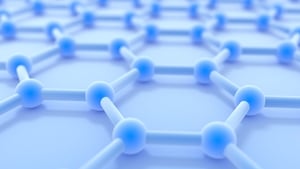 Nanotechnology has a wide range of potential usages that could produce advancements in medical treatment, pharm tech, food transportation and the electronics industry. A nanometer, the scale used for nanotechnology, is one billionth of a meter. For a sense of scale, a sheet of paper is 100,000 nanometers thick.1 As you can see, nanotechnology,any technology that operates between 1-100 nanometers, works on an unfathomably small scale. However, despite many positive signs that the technology has possible societal impact, there are some objectors who oppose the science’s future on ethical and legal grounds. However, many of their arguments are vaguely defined and lack substantiative evidence. What is certain is that nanotechnology is at the forefront of technology and industry. The science has many specific benefits that are already being researched to improve heart health, provide more efficient solar power and elongate the shelf life of vegetables.
Nanotechnology has a wide range of potential usages that could produce advancements in medical treatment, pharm tech, food transportation and the electronics industry. A nanometer, the scale used for nanotechnology, is one billionth of a meter. For a sense of scale, a sheet of paper is 100,000 nanometers thick.1 As you can see, nanotechnology,any technology that operates between 1-100 nanometers, works on an unfathomably small scale. However, despite many positive signs that the technology has possible societal impact, there are some objectors who oppose the science’s future on ethical and legal grounds. However, many of their arguments are vaguely defined and lack substantiative evidence. What is certain is that nanotechnology is at the forefront of technology and industry. The science has many specific benefits that are already being researched to improve heart health, provide more efficient solar power and elongate the shelf life of vegetables.
Nanotechnology in the medical industry
Recent research done by scientists at the University of Bath and Bristol has used nanotechnology to develop a pacemaker that could help prevent heart failure and extend the lives of those who have suffered from cardiovascular disease.2 The study explains that the heart beats in correlation with the lungs, causing rhythmic patterns that allow the heart to function efficiently. That is to say, our rate of breathing directly influence to our heart rate. Cardiovascular disease throws off variations in heart rate that synchronize with lung inflations, causing a discordance that can lead to heart failure. The device created by scientists, an updated pacemaker, enhances the heart’s ability to pump blood efficiently and saves energy.3 The pacemaker the team created is miniaturized, about the size of a postage stamp, and they expect to be able to significantly extend the life of those who experience heart failure.4 Traditional pacemakers are set to keep heartbeats at a constant rate, whereas the heart does not function that way naturally within the body.5 Giving pacemakers the ability to work closer with the lungs and form natural rhythms with the body puts less stress on the muscle.
Nanotechnology in agriculture
In food science, the use of nanotechnology can potentially elongate the life of fruits and vegetables. This could be achieved, for example, by putting nanoparticles of silver into foods to work as an antibacterial agent.6 These nanoparticles would not be a large enough component of the food to have a harmful effect or alter the flavor. In fact, many food manufacturers already use nanotechnology in food. The Food and Drug Administration doesn’t have a specific stance on nanotechnology. However, the organization has recently requested that companies using nanotechnology consult it to discuss the product. This could include a wide range of products including medical services, foodstuffs and cosmetics, though the FDA is specifically focused on the latter two.7 It would appear for the moment the FDA mainly wants to be considered a consultant when companies opt to use nanotechnology. Skin moisturizers, sunscreen and other cosmetics have been using nanoparticles for some time, but the FDA generally has less control over this industry.8
Nanotechnology in society
Perhaps the most intriguing aspect of nanotechnology in regard to agriculture is the potential for artificial photosynthesis to be utilized in regard to solar power. Scientists have used a device called a water splitter which allows hydrogen to be produced to create power when the sun is not directly shining. But this device relies silicon, which corrodes quickly when put in contact with electrolytes, and therefore in the past has only been able to be used in short durations.Using nanotechnology to develop solar energy could potentially increase sustainability. Scientists at the University of Stanford prevented a silicon-based water splitter from corroding by plating it with two nanometers of nickel.9 Plating the silicon cell with nickel has lead to promising results, but additional testing is needed to make the fueling method cost effective.10 Nanotechnology is also being used to develop long-term environmental clean up functions, specifically to help remove pollutants from air and water.11 This is being done by creating miniscule filters that collect toxic particles. The technology is also has been used in developments in the electronics, IT and transportation industries.
Ethical and legal implications
Nanotechnology comes with some risks, specifically in regard to food, as products utilizing the technology haven’t undergone heavy testing and are not currently subject to labeling. The reason organizations such as the FDA are yet to take a strong stance on nanotechnology products is because there is yet to be any definitive evidence that nanoparticles are a safety risk. The organization wants to prudently catalog and monitor product development, but does not have any reason to inhibit usage. However, some advocacy groups attest that the lack of labeling and regulation on nanoproducts has a harmful societal impact.12 The focus of these groups, such as Friends of the Earth, is to change policy to have food products that use nanoparticles labeled. Additionally, the organization focuses on potentially toxic nanoparticles found in sunscreen and cosmetics. 1“What is Nanotechnology” National Nanotechnology Initiative. http://www.nano.gov/nanotech-101/what/definition 2“New pacemaker that synchronises heart rate with breathing” University of Bristol. June 23, 2014. http://bristol.ac.uk/news/2014/june/new-pacemaker.html 3“New pacemaker that synchronises heart rate with breathing” University of Bristol. June 23, 2014. http://bristol.ac.uk/news/2014/june/new-pacemaker.html 4“New pacemaker that synchronises heart rate with breathing” University of Bristol. June 23, 2014. http://bristol.ac.uk/news/2014/june/new-pacemaker.html 5“New pacemaker that synchronises heart rate with breathing” University of Bristol. June 23, 2014. http://bristol.ac.uk/news/2014/june/new-pacemaker.html 6“Nanotechnology may change how we grow food” by Nikolai Beilharz. ABC Rural. June 24, 2014. http://www.abc.net.au/news/2014-06-24/nanotech-artifical-photosynthesis/5546782 7“FDA outlines policy for overseeing nanotechnology” by Matthew Perrone. June 24, 2014. http://www.wral.com/fda-outlines-policy-for-overseeing-nanotechnology/13761140/ 8“FDA outlines policy for overseeing nanotechnology” by Matthew Perrone. June 24, 2014. http://www.wral.com/fda-outlines-policy-for-overseeing-nanotechnology/13761140/ 9“Stanford scientists create a durable, low-cost water splitter made of silicon and nickel” by Mark Shwartz. Stanford News. November 24, 2014. http://news.stanford.edu/pr/2013/pr-nickel-water-splitter-111213.html 10“Stanford scientists create a durable, low-cost water splitter made of silicon and nickel” by Mark Shwartz. Stanford News. November 24, 2014. http://news.stanford.edu/pr/2013/pr-nickel-water-splitter-111213.html 11“Benefits and Applications” National Nanotechnology Initiative. http://www.nano.gov/you/nanotechnology-benefits 12“Tiny ingredients, big risks” Friends of the Earth. May 21, 2104 http://www.foe.org/news/news-releases/2014-05-new-report-tiny-ingredients-big-risks



